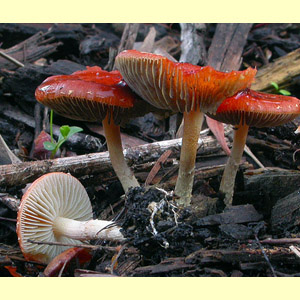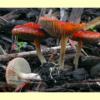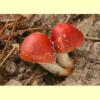
images/Leratiomyces_ceres/Hypholoma_aurantiacum_TM_DSCN7314a.jpg
Small to medium agaric growing typically in litter or mulch, sometimes on the ground or wood, rarely on dung, with a purple-brown spore print. Pileus orange, brown or red, viscid when fresh but often appearing dry. Lamellae adnexed, adnate or sinuate or notched. Stipe central. Partial veil remnants a ring zone. Spores brown; germ pore broad. Cheilocystidia present; pleurocystidia present as chrysocystidia. Lamellar trama regular. Pileipellis a cutis; hypoderm subcellular. Clamp connections present.
Similar to
Hypholoma, especially
H. australe, which also has a red pileus, but the latter grows in caespitose clusters on larger wood (often buried) or stumps rather than in mulch and it has smaller spores (6–8.5 µm long compared to 9–15 µm long in
L. ceres). The viscid pileus (when fresh) of
Leratiomyces ceres also serves to distinguish it from similar-looking species of
Hypholoma. Among other agarics with a purple-brown spore print
Psilocybe lacks chrysocystidia (at least the Australian species) and
Stropharia, which has chrysocystidia, lacks the subcellular hypoderm to the pileipellis.
Leratiomyces Bresinsky & Binder ex Bridge, Spooner, Beever & D.-C.Park, Mycotaxon 103: 115 (2008).
Stropholoma (Singer) Balletto.
One species:
Leratiomyces ceres (until recently called
Hypholoma aurantiacum,
Stropharia aurantiaca or
Stropholoma aurantiaca).
Leratiomyces ceres (Cooke & Massee) Spooner & Bridge in Bridge et al., Mycotaxon 103: 116 (2008).
W.A., S.A., Qld, N.S.W., Vic. and Tas. (and probably also N.T.).
Typically in parks and gardens, but also in native forests (for example, on flood debris).
On mulch and litter, especially wood chip mulch, or on the ground. Recorded once on dung.
Saprotrophic.
Bougher, N.L. (2009a),
Fungi of the Perth region and beyond: a self-managed field book, Western Australian Naturalists' Club (Inc.), Perth. [
Description and
Illustration of
L. ceres]
Fuhrer, B. (2005), A Field Guide to Australian Fungi. Bloomings Books, Hawthorn. [Description and Illustration of L. ceres (as Hypholoma aurantiacum)]
Grgurinovic, C.A. (1997a), Larger Fungi of South Australia. The Botanic Gardens of Adelaide and State Herbarium and The Flora and Fauna of South Australia Handbooks Committee, Adelaide. [Description, Illustration and Microcharacters of L. ceres (as H. aurantiacum)]
Guzmán, G. (1975), New and interesting species of Agaricales of Mexico, Beih. Nova Hedwigia 51: 99–118. [Description, B&W Illustration and Microcharacters of L. ceres (as Naematoloma aurantiacum)]
McCann, I.R. (2003), Australian Fungi Illustrated. Macdown Productions, Vermont. [Illustration of L. ceres (as H. aurantiacum)]
Reid, D.A. (1966), Coloured icones of rare and interesting fungi. Fascicle 1. Nova Hedwigia 11 (suppl.): 1–32. [Description, Illustration and Microcharacters of L. ceres (as Stropharia aurantiaca)]
Young, A.M. (2005b), A Field Guide to the Fungi of Australia. University of New South Wales Press, Sydney. [Illustration and Description of L. ceres (as Stropharia aurantiaca)]





